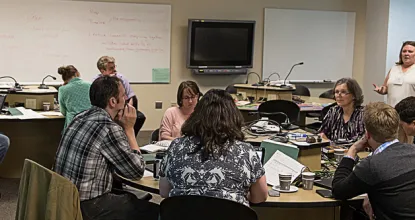The resources here are for Peer Observation of teaching - the voluntary process to have a reviewer observe and provide input on teaching. This is different from Peer Evaluation of teaching, which is the review of teaching with the purpose of assessing and improving the quality of teaching as described contractually.
In-class observation is often considered a critical component of peer evaluation, though it is important to remember that it is not the only aspect of effective peer review. This page gives some suggestions for improving in-class observation for the purposes of the improvement of teaching.
Components of an in-class visit:
Pre-visit Meeting - Reviewer should meet with the instructor to be observed, in person if possible. They should discuss the context for the lesson that they will observe. This might include links to content areas, learning outcomes, lesson plans, etc. They should discuss the type of teaching approach that will be used and any preparatory activities that students will have engaged in to prepare for the course. They should discuss any areas where the instructor would like specific input from the observer as well as any concerns resulting from previous observations. You may want to consider having a form or list of topics to be covered when you (as the observer) meets with the instructor.
Course Material Review - At a minimum, the observer should be provided with the syllabus. It is preferable that the observer would also be able to review any additional materials to be used such as handout, assignment links, etc.
Observation of a Class Session - Observations often address multiple aspects of delivery of course material. It is advisable to have some type of organizing form to assure consistency in your observation. There are many forms available that may assist your observation including the following types:
- Narrative Log (with or without defined questions) (see Peer Review of Teaching: A Sourcebook by Nancy Van Note Chism (2007) for examples)
- Checklists (yes/no forms)
- Scale rating forms (e.g. 1-5 number scale)
- Rubrics (rating form linked to proficiency standards)
If you decide to use a form, it is best practice to ensure that all observers using the form understand it and use it in a similar manner (i.e. validate).
Post-visit Meeting - After the session has been observed, the observer should immediately gather their materials together and meet with the instructor that they observed. This should occur as soon as possible following the class session to ensure that the session remains fresh in the minds of both parties. During this meeting, they should address any specific areas where the instructor sought input. The instructor should be encouraged to give their own opinion of how the session went. They should discuss the overall success of the presentation, student involvement, teaching style and effectiveness and any other instructional strengths or weaknesses of the session.
Peer Observation Program - The Teaching & Learning Advisory Council in conjunction with the Center for Teaching and Learning offer a Peer Observation program. To request a formative peer observation, please complete this form.
